Mitigating Source Water Risks with Improved Wildfire Containment
Abstract
:1. Introduction
2. Materials and Methods
2.1. Evaluation Framework
2.2. Study Area
2.3. Potential Fire Operational Delineations
2.4. Fire Occurrence
2.5. Fire Behavior and Severity
2.6. Post-Fire Watershed Response
2.6.1. Hillslope Erosion
2.6.2. Hillslope Sediment Transport
2.6.3. Channel Sediment Transport
2.7. Water Supply Impacts
2.8. Containment Effectiveness Evaluation and Prioritization
3. Results
3.1. Fire Occurrence
3.2. Fire Behavior and Severity
3.3. Watershed Response
3.4. Avoided Watershed Area Burned
3.5. Avoided Sediment
3.6. Avoided Water Quality Degradation
3.7. Prioritizing POD Network Improvements
4. Discussion
5. Conclusions
Author Contributions
Funding
Acknowledgments
Conflicts of Interest
References
- O’Connor, C.D.; Thompson, M.P.; Rodríquez y Silva, F. Getting ahead of the wildfire problem: Quantifying and mapping management challenges and opportunities. Geosciences 2016, 6, 35. [Google Scholar] [CrossRef] [Green Version]
- Thompson, M.P.; Bowden, P.; Brough, A.; Scott, J.H.; Gilbertson-Day, J.; Taylor, A.; Anderson, J.; Haas, J.R. Application of wildfire risk assessment results to wildfire response planning in the Southern Sierra Nevada, California, USA. Forests 2016, 7, 64. [Google Scholar] [CrossRef]
- Thompson, M.P.; MacGregor, D.G.; Dunn, C.J.; Calkin, D.E.; Phipps, J. Rethinking the wildland fire management system. J. For. 2018, 116, 382–390. [Google Scholar] [CrossRef] [Green Version]
- Caggiano, M.D. Collaboratively Engaging Stakeholders to Develop Potential Operational Delineations; Report CFRI-1908; Colorado Forest Restoration Institute: Fort Collins, CO, USA, 2019. [Google Scholar]
- Caggiano, M.D.; O’Connor, C.D.; Sack, R.B. Potential Operational Delineations and Northern New Mexico’s 2019 Fire Season; Report CFRI-2002; Colorado Forest Restoration Institute: Fort Collins, CO, USA, 2019. [Google Scholar]
- Greiner, M.; Kooistra, C.; Schultz, C. Pre-Season Planning for Wildland Fire Response: An Assessment of the US Forest Service’s Potential Operational Delineations (PODs); Practitioner Paper #05; Public Lands Policy Group at Colorado State University: Fort Collins, CO, USA, 2020. [Google Scholar]
- Dunn, C.J.; O’Connor, C.D.; Abrams, J.; Thompson, M.P.; Calkin, D.E.; Johnston, J.D.; Stratton, R.; Gilbertson-Day, J. Wildfire risk science facilitates adaptation of fire-prone social-ecological systems to the new fire reality. Environ. Res. Lett. 2020, 15, 025001. [Google Scholar] [CrossRef]
- Stratton, R.D. The path to strategic wildland fire management planning. Wildfire Mag. 2020, 29, 24–31. [Google Scholar]
- DeBano, L.F.; Neary, D.G.; Ffolliott, P.F. Soil physical processes. In Wildland Fire in Ecosystems: Effects of Fire on Soils and Water; Neary, D.G., Ryan, K.C., Eds.; General Technical Report RMRS-GTR-42; USDA Forest Service, Rocky Mountain Research Station: Ogden, UT, USA, 2005; Volume 4, pp. 29–51. [Google Scholar]
- Shakesby, R.A.; Doerr, S.H. Wildfire as a hydrological and geomorphological agent. Earth Sci. Rev. 2006, 74, 269–307. [Google Scholar] [CrossRef]
- Larsen, I.J.; MacDonald, L.H.; Brown, E.; Rough, D.; Welsh, M.J.; Pietraszek, J.H.; Libohova, Z.; Benavides-Solorio, J.D.; Schaffrath, K. Causes of post-fire runoff and erosion: Water repellency, cover, or soil sealing? Soil Sci. Soc. Am. J. 2009, 73, 1393–1407. [Google Scholar] [CrossRef] [Green Version]
- Smith, H.G.; Sheridan, G.J.; Lane, P.N.J.; Nyman, P.; Haydon, S. Wildfire effects on water quality in forest catchments: A review with implications for water supply. J. Hydrol. 2011, 396, 170–192. [Google Scholar] [CrossRef]
- Emelko, M.B.; Silins, U.; Bladon, K.D.; Stone, M. Implications of land disturbance on drinking water treatability in a changing climate: Demonstrating the need for “source water supply and protection” strategies. Water Res. 2011, 45, 461–472. [Google Scholar] [CrossRef]
- Abraham, J.; Dowling, K.; Florentine, S. Risk of post-fire metal mobilization into surface water resources: A review. Sci. Total Environ. 2017, 599–600, 1740–1755. [Google Scholar] [CrossRef]
- Murphy, S.F.; Writer, J.H.; McCleskey, R.B.; Martin, D.A. The role of precipitation type, intensity, and spatial distribution in source water quality after wildfire. Environ. Res. Lett. 2015, 10, 084007. [Google Scholar] [CrossRef]
- Benavides-Solorio, J.D.; MacDonald, L.H. Measurement and prediction of post-fire erosion at the hillslope scale, Colorado Front Range. Int. J. Wildland Fire 2005, 14, 457–474. [Google Scholar] [CrossRef] [Green Version]
- Schmeer, S.R.; Kampf, S.K.; MacDonald, L.H.; Hewitt, J.; Wilson, C. Empirical models of annual post-fire erosion on mulched and unmulched hillslopes. Catena 2018, 163, 276–287. [Google Scholar] [CrossRef]
- Omi, P.N. Planning future fuelbreak strategies using mathematical modeling techniques. Environ. Manag. 1979, 3, 73–80. [Google Scholar] [CrossRef]
- Thompson, M.P.; Scott, J.; Langowski, P.G.; Gilbertson-Day, J.W.; Haas, J.R.; Bowne, E.M. Assessing watershed-wildfire risks on national forest system lands in the Rocky Mountain region of the United States. Water 2013, 5, 945–971. [Google Scholar] [CrossRef] [Green Version]
- Cannon, S.H.; Gartner, J.E.; Rupert, M.G.; Michael, J.A.; Rea, A.H.; Parrett, C. Predicting the probability and volume of post-wildfire debris flows in the intermountain western United States. Geol. Soc. Am. Bull. 2010, 122, 127–144. [Google Scholar] [CrossRef]
- Miller, M.E.; MacDonald, L.H.; Robichaud, P.R.; Elliot, W.J. Predicting post-fire hillslope erosion in forest lands of the western United States. Int. J. Wildland Fire 2011, 20, 982–999. [Google Scholar] [CrossRef]
- Miller, M.E.; Elliot, W.J.; Billmire, M.; Robichaud, P.R.; Endsley, K.A. Rapid-response tools and datasets for post-fire remediation: Linking remote sensing and process-based hydrological models. Int. J. Wildland Fire 2016, 25, 1061–1073. [Google Scholar] [CrossRef]
- Sidman, G.; Guertin, D.P.; Goodrich, D.C.; Thoma, D.; Falk, D.; Burns, I.S. A coupled modelling approach to assess the effect of fuel treatments on post-wildfire runoff and erosion. Int. J. Wildland Fire 2016, 25, 351–362. [Google Scholar] [CrossRef]
- Gannon, B.M.; Wei, Y.; MacDonald, L.H.; Kampf, S.K.; Jones, K.W.; Cannon, J.B.; Wolk, B.H.; Cheng, A.S.; Addington, R.N.; Thompson, M.P. Prioritising fuels reduction for water supply protection. Int. J. Wildland Fire 2019, 28, 785–803. [Google Scholar] [CrossRef] [Green Version]
- Elliot, W.J.; Miller, M.E.; Enstice, N. Targeting forest management through fire and erosion modelling. Int. J. Wildland Fire 2016, 25, 876–887. [Google Scholar] [CrossRef]
- Jones, K.W.; Cannon, J.B.; Saavedra, F.A.; Kampf, S.K.; Addington, R.N.; Cheng, A.S.; MacDonald, L.H.; Wilson, C.; Wolk, B. Return on investment from fuel treatments to reduce severe wildfire and erosion in a watershed investment program in Colorado. J. Environ. Manag. 2017, 198, 66–77. [Google Scholar] [CrossRef] [PubMed] [Green Version]
- Thompson, M.P.; Liu, Z.; Wei, Y.; Caggiano, M.D. Analyzing wildfire suppression difficulty in relation to protection demand. In Environmental Risks; Mihai, F.-C., Grozavu, A., Eds.; IntechOpen Limited: London, UK, 2018; pp. 45–64. [Google Scholar] [CrossRef] [Green Version]
- Wei, Y.; Thompson, M.P.; Haas, J.R.; Dillon, G.K.; O’Connor, C.D. Spatial optimization of operationally relevant large fire confine and point protection strategies: Model development and test cases. Can. J. For. Res. 2018, 48, 480–493. [Google Scholar] [CrossRef] [Green Version]
- Rodríguez y Silva, F.; Molina Martínez, J.R.; González-Cabán, A. A methodology for determining operational priorities for prevention and suppression of wildland fires. Int. J. Wildland Fire 2014, 23, 544–554. [Google Scholar] [CrossRef]
- O’Connor, C.D.; Calkin, D.E.; Thompson, M.P. An empirical machine learning method for predicting potential fire control locations for pre-fire planning and operational fire management. Int. J. Wildland Fire 2017, 26, 587–597. [Google Scholar] [CrossRef]
- Rodríguez y Silva, F.; O’Connor, K.; Thompson, M.P.; Molina Martínez, J.R.; Calkin, D.E. Modelling suppression difficulty: Current and future applications. Int. J. Wildland Fire 2020, in press. [Google Scholar] [CrossRef]
- Thompson, M.P.; Gilbertson-Day, J.W.; Scott, J.H. Integrating pixel- and polygon-based approaches to wildfire risk assessment: Applications to a high-value watershed on the Pike and San Isabel National Forests, Colorado, USA. Environ. Model. Assess. 2016, 21, 1–15. [Google Scholar] [CrossRef]
- Haas, J.R.; Thompson, M.; Tillery, A.; Scott, J.H. Capturing spatiotemporal variation in wildfires for improving post-wildfire debris-flow hazard assessments. In Natural Hazard Uncertainty Assessment: Modeling and Decision Support, Geophysical Monograph 223; Riley, K., Webley, P., Thompson, M., Eds.; John Wiley & Sons: Hoboken, NJ, USA, 2017; pp. 301–317. [Google Scholar]
- Gannon, B.M.; Wei, Y.; Thompson, M.P.; Scott, J.H.; Short, K.C. System analysis of wildfire-water supply risk in Colorado, U.S.A. with Monte Carlo wildfire and rainfall simulation. Risk Anal. 2020. in review. [Google Scholar]
- Haas, J.R.; Calkin, D.E.; Thompson, M.P. Wildfire risk transmission in the Colorado Front Range, USA. Risk Anal. 2015, 35, 226–240. [Google Scholar] [CrossRef]
- Ager, A.A.; Palaiologou, P.; Evers, C.R.; Day, M.A.; Barros, A.M.G. Assessing transboundary wildfire exposure in the southwestern United States. Risk Anal. 2018, 38, 2105–2127. [Google Scholar] [CrossRef] [Green Version]
- Finney, M.A. The challenge of quantitative risk analysis for wildland fire. For. Ecol. Manag. 2005, 211, 97–108. [Google Scholar] [CrossRef]
- Scott, J.H.; Thompson, M.P.; Calkin, D.E. A Wildfire Risk Assessment Framework for Land and Resource Management; General Technical Report RMRS-GTR-315; USDA Forest Service, Rocky Mountain Research Station: Fort Collins, CO, USA, 2013.
- Finney, M.A. An overview of FlamMap fire modeling capabilities. In Proceedings of the Fuels Management-How to Measure Success Conference, Portland, OR, USA, 28–30 March 2006; Andrews, P.L., Butler, B.W., Eds.; Proceedings RMRS-P-41. USDA Forest Service, Rocky Mountain Research Station: Fort Collins, CO, USA, 2006; pp. 213–220. [Google Scholar]
- Finney, M.A.; Brittain, S.; Seli, R.C.; McHugh, C.W.; Gangi, L. FlamMap: Fire Mapping and Analysis System, Version 5.0; USDA Forest Service, Rocky Mountain Research Station: Fort Collins, CO, USA, 2015. Available online: http://www.firelab.org/document/flammap-software (accessed on 1 November 2019).
- Renard, K.G.; Foster, G.R.; Weesies, G.A.; McCool, D.K.; Yoder, D.C. Predicting Soil Erosion by Water: A Guide to Conservation Planning with the Revised Universal Soil Loss Equation (RUSLE); Handbook no. 703; USDA Agricultural Research Service Agricultural: Washington, DC, USA, 1997.
- Wagenbrenner, J.W.; Robichaud, P.R. Post-fire bedload sediment delivery across spatial scales in the interior western United States. Earth Surf. Process. Landf. 2014, 39, 865–876. [Google Scholar] [CrossRef]
- Frickel, D.G.; Shown, L.M.; Patton, P.C. An Evaluation of Hillslope and Channel Erosion Related to Oil-Shale Development in the Piceance Basin, North-Western Colorado; Colorado Department of Natural Resources, Colorado Water Resources Circular 30: Denver, CO, USA, 1975. [Google Scholar]
- R Core Team. R: A Language and Environment for Statistical Computing, Version 3.5.3; R Foundation for Statistical Computing: Vienna, Austria, 2019; Available online: https://www.R-project.org/ (accessed on 1 May 2019).
- Moody, J.A.; Martin, D.A. Initial hydrologic and geomorphic response following a wildfire in the Colorado Front Range. Earth Surf. Process. Landf. 2001, 26, 1049–1070. [Google Scholar] [CrossRef]
- Graham, R.T. Hayman Fire Case Study; USDA Forest Service, Rocky Mountain Research Station, General Technical Report RMRS-GTR-114: Ogden, UT, USA, 2003. [Google Scholar]
- Wagenbrenner, J.W.; MacDonald, L.H.; Rough, D. Effectiveness of three post-fire rehabilitation treatments in the Colorado Front Range. Hydrol. Process. 2006, 20, 2989–3006. [Google Scholar] [CrossRef] [Green Version]
- Oropeza, J.; Heath, J. Effects of the 2012 Hewlett and High Park Wildfires on Water Quality of the Poudre River and Seaman Reservoir; City of Fort Collins Utilities Report: Fort Collins, CO, USA, 2013. [Google Scholar]
- Moody, J.A.; Martin, D.A. Synthesis of sediment yields after wildland fire in different rainfall regimes in the western United States. Int. J. Wildland Fire 2009, 18, 96–115. [Google Scholar] [CrossRef]
- LANDFIRE. Fuel, Topography, Existing Vegetation Type, and Fuel Disturbance Layers, Version 1.4.0.; USDOI Geological Survey: Washington, DC, USA, 2016. Available online: http://landfire.cr.usgs.gov/viewer/ (accessed on 23 August 2016).
- Price, O.; Bradstock, R. The effect of fuel age on the spread of fire in sclerophyll forest in the Sydney region of Australia. Int. J. Wildland Fire 2010, 19, 35–45. [Google Scholar] [CrossRef] [Green Version]
- Narayanaraj, G.; Wimberly, M.C. Influences of forest roads on the spatial pattern of wildfire boundaries. Int. J. Wildland Fire 2011, 20, 792–803. [Google Scholar] [CrossRef]
- Yocum, L.L.; Jenness, J.; Fulé, P.Z.; Thode, A.E. Previous fires and roads limit wildfire growth in Arizona and New Mexico, U.S.A. For. Ecol. Manag. 2019, 449, 117440. [Google Scholar] [CrossRef]
- Scott, J.H.; Burgan, R.E. Standard Fire Behavior Fuel Models: A Comprehensive Set for Use with Rothermel’s Surface Fire Spread Model; General Technical Report RMRS-GTR-153; USDA Forest Service, Rocky Mountain Research Station: Fort Collins, CO, USA, 2005.
- Moriarty, K.; Cheng, A.S.; Hoffman, C.M.; Cottrell, S.P.; Alexander, M.E. Firefighter observations of “surprising” fire behavior in mountain pine beetle-attacked lodgepole pine forests. Fire 2019, 2, 34. [Google Scholar] [CrossRef] [Green Version]
- Short, K.C. Spatial Wildfire Occurrence Data for the United States, 1992–2015, 4th ed; USDA Forest Service Research Data Archive: Fort Collins, CO, USA, 2017. [Google Scholar] [CrossRef]
- ESRI. ArcGIS, Version 10.3; Environmental Systems Research Institute: Redlands, CA, USA, 2015; Available online: https://www.esri.com/en-us/home (accessed on 1 July 2017).
- NWCG. Remote Automated Weather Station Data; National Wildfire Coordinating Group: Washington, DC, USA, 2018. Available online: https://fam.nwcg.gov/fam-web/weatherfirecd/index.htm (accessed on 6 June 2018).
- Bradshaw, L.; McCormick, E. FireFamily Plus User’s Guide, Version 2.0; General Technical Report RMRS-GTR-67WWW; USDA Forest Service, Rocky Mountain Research Station: Ogden, UT, USA, 2000.
- Crosby, J.S.; Chandler, C.C. Get the most from your windspeed observation. Fire Control Notes 1966, 27, 12–13. [Google Scholar]
- Scott, J.H.; Reinhardt, E.D. Assessing Crown Fire Potential by Linking Models of Surface and Crown Fire Behavior; General Technical Research Paper RMRS-RP-29; USDA Forest Service, Rocky Mountain Research Station: Fort Collins, CO, USA, 2001.
- Tillery, A.C.; Haas, J.R.; Miller, L.W.; Scott, J.H.; Thompson, M.P. Potential Post-Wildfire Debris-Flow Hazards—A Pre-Wildfire Evaluation for the Sandia and Manzano Mountains and Surrounding Areas, Central New Mexico; Scientific Investigations Report 2014-5161; US Geological Survey: Albuquerque, NM, USA, 2014.
- USEPA; USGS. National Hydrography Dataset Plus—NHDPlus, Version 2.1; US Environmental Protection Agency and USDOI Geological Survey: Washington, DC, USA, 2012. Available online: http://www.horizon-systems.com/NHDPlus/index.php (accessed on 23 August 2016).
- Theobald, D.M.; Merritt, D.M.; Norman, J.B. Assessment of Threats to Riparian Ecosystems in the Western U.S.; Report to the Western Environmental Threats Assessment Center by the USDA Stream Systems Technology Center and Colorado State University: Fort Collins, CO, USA, 2010. [Google Scholar]
- Perica, S.; Martin, D.; Pavlovic, S.; Roy, I.; St. Laurent, M.; Trypaluk, C.; Unruh, D.; Yekta, M.; Bonnin, G. NOAA Atlas 14, Volume 8 Precipitation-Frequency Atlas of the United States, Midwestern States, Version 2; US National Oceanic and Atmospheric Administration: Silver Spring, MD, USA, 2013. [Google Scholar]
- Wilson, C.; Kampf, S.K.; Wagenbrenner, J.W.; MacDonald, L.H. Rainfall thresholds for post-fire runoff and sediment delivery from plot to watershed scales. For. Ecol. Manag. 2018, 430, 346–356. [Google Scholar] [CrossRef]
- Winchell, M.F.; Jackson, S.H.; Wadley, A.M.; Srinivasan, R. Extension and validation of a geographic information system-based method for calculating the Revised Universal Soil Loss Equation length-slope factor for erosion risk assessments in large watersheds. J. Soil Water Conserv. 2008, 63, 105–111. [Google Scholar] [CrossRef]
- NRCS Soil Survey Staff. Web Soil Survey; USDA Natural Resources Conservation Service: Washington, DC, USA, 2016. Available online: https://websoilsurvey.nrcs.usda.gov/ (accessed on 23 August 2016).
- Larsen, I.J.; MacDonald, L.H. Predicting post-fire sediment yields at the hillslope scale: Testing RUSLE and disturbed WEPP. Water Resour. Res. 2007, 43, W11412. [Google Scholar] [CrossRef] [Green Version]
- Henkle, J.E.; Wohl, E.; Beckman, N. Locations of channel heads in the semiarid Colorado Front Range, USA. Geomorphology 2011, 129, 309–319. [Google Scholar] [CrossRef]
- Ryan, S.E.; Dwire, K.A.; Dixon, M.K. Impacts of wildfire on runoff and sediment loads at Little Granite Creek, western Wyoming. Geomorphology 2011, 129, 113–130. [Google Scholar] [CrossRef]
- Schmeer, S.R. Post-Fire Erosion Response and Recovery, High Park Fire, Colorado. Master’s Thesis, Colorado State University, Fort Collins, CO, USA, 2014. [Google Scholar]
- Sham, C.H.; Tuccillo, M.E.; Rooke, J. Effects of Wildfire on Drinking Water Utilities and Best Practices for Wildfire Risk Reduction and Mitigation; Report 4482; Water Research Foundation: Denver, CO, USA, 2013. [Google Scholar]
- Writer, J.H.; Hohner, A.; Oropeza, J.; Schmidt, A.; Cawley, K.M.; Rosario-Ortiz, F.L. Water treatment implications after the High Park Wildfire, Colorado. J. Am. Water Works Assn. 2014, 106, 189–199. [Google Scholar] [CrossRef]
- Sherriff, R.L.; Platt, R.V.; Veblen, T.T.; Schoennagel, T.L.; Gartner, M.H. Historical, observed, and modeled wildfire severity in montane forests of the Colorado Front Range. PLoS ONE 2014, 9, e106971. [Google Scholar] [CrossRef] [Green Version]
- Davis, L.S. The Economics of Wildfire Protection with Emphasis on Fuel Break Systems; California Division of Forestry: Sacramento, CA, USA, 1965. [Google Scholar]
- Wilson, A.A.G. Width of firebreak that is necessary to stop grass fires: Some field experiments. Can. J. For. Res. 1988, 18, 682–687. [Google Scholar] [CrossRef]
- Mees, R.; Strauss, D.; Chase, R. Modeling wildland fire containment with uncertain flame length and fireline width. Int. J. Wildland Fire 1993, 3, 179–185. [Google Scholar] [CrossRef]
- Agee, J.K.; Bahro, B.; Finney, M.A.; Omi, P.N.; Sapsis, D.B.; Skinner, C.N.; van Wagtendonk, J.W.; Weatherspoon, C.P. The use of shaded fuelbreaks in landscape fire management. For. Ecol. Manag. 2000, 127, 55–66. [Google Scholar] [CrossRef]
- O’Connor, C.D.; Calkin, D.E. Engaging the fire before it starts: A case study from the 2017 Pinal Fire (Arizona). Wildfire Mag. 2019, 28, 14–18. [Google Scholar]
- Ingalsbee, T. Ecological fire use for ecological fire management: Managing large wildfires by design. In Proceedings of the Large Wildland Fires Conference, Missoula, MT, USA, 19–23 May 2014; Keane, R.E., Matt, J., Parsons, R., Riley, K., Eds.; Proceedings RMRS-P-73. USDA Forest Service Rocky Mountain Research Station: Fort Collins, CO, USA, 2015; pp. 120–127. [Google Scholar]
- Blake, D.; Nyman, P.; Nice, H.; D’Souza, F.M.L.; Kavazos, C.R.J.; Horwitz, P. Assessment of post-wildfire erosion risk and effects on water quality in south-western Australia. Fire 2020, 29, 240–257. [Google Scholar] [CrossRef] [Green Version]
- Moody, J.A.; Shakesby, R.A.; Robichaud, P.R.; Cannon, S.H.; Martin, D.A. Current research issues related to post-wildfire runoff and erosion processes. Earth Sci. Rev. 2013, 122, 10–37. [Google Scholar] [CrossRef]
- Robichaud, P.R.; Lewis, S.A.; Wagenbrenner, J.W.; Ashmun, L.E.; Brown, R.E. Post-fire mulching for runoff and erosion mitigation Part I: Effectiveness at reducing hillslope erosion rates. Catena 2013, 105, 75–92. [Google Scholar] [CrossRef]
- Robichaud, P.R.; Wagenbrenner, J.W.; Brown, R.E.; Wohlgemuth, P.M.; Beyers, J.L. Evaluating the effectiveness of contour-felled log erosion barriers as a post-fire runoff and erosion mitigation treatment in the western United States. Int. J. Wildland Fire 2008, 17, 255–273. [Google Scholar] [CrossRef]
- Robichaud, P.R.; Wagenbrenner, J.W.; Lewis, S.A.; Ashmun, L.E.; Brown, R.E.; Wohlgemuth, P.M. Post-fire mulching for runoff and erosion mitigation Part II: Effectiveness in reducing runoff and sediment yields from small catchments. Catena 2013, 105, 93–111. [Google Scholar] [CrossRef]
- Ferro, V.; Porto, P. Sediment Delivery Distributed (SEDD) Model. J. Hydrol. Eng. 2000, 5, 411–422. [Google Scholar] [CrossRef]
- Fernandez, C.; Wu, J.Q.; McCool, D.K.; Stöckle, C.O. Estimating water erosion and sediment yield with GIS, RUSLE, and SEDD. J. Soil Water Conserv. 2003, 58, 128–136. [Google Scholar]
- Rhoades, C.C.; Entwistle, D.; Butler, D. The influence of wildfire extent and severity on streamwater chemistry, sediment and temperature following the Hayman Fire, Colorado. Int. J. Wildland Fire 2011, 20, 430–442. [Google Scholar] [CrossRef]
- Kampf, S.K.; Brogan, D.J.; Schmeer, S.; MacDonald, L.H.; Nelson, P.A. How do geomorphic effects of rainfall vary with storm type and spatial scale in a post-fire landscape? Geomorphology 2016, 273, 39–51. [Google Scholar] [CrossRef] [Green Version]
- Diodato, N.; Bellocchi, G. Reconstruction of seasonal net erosion in a Mediterranean landscape (Alento River Basin, Southern Italy) over the past five decades. Water 2019, 11, 2306. [Google Scholar] [CrossRef] [Green Version]
- Hohner, A.K.; Cawley, K.; Oropeza, J.; Summers, R.S.; Rosario-Ortiz, F.L. Drinking water treatment response following a Colorado wildfire. Water Res. 2016, 105, 187–198. [Google Scholar] [CrossRef]
- Salis, M.; Del Giudice, L.; Robichaud, P.R.; Ager, A.A.; Canu, A.; Duce, P.; Pellizzaro, G.; Ventura, A.; Alcasena-Urdiroz, F.; Spano, D.; et al. Coupling wildfire spread and erosion models to quantify post-fire erosion before and after fuel treatments. Int. J. Wildland Fire 2019, 28, 687–703. [Google Scholar] [CrossRef]
- Chambers, M.E.; Fornwalt, P.J.; Malone, S.L.; Battaglia, M.A. Patterns of conifer regeneration following high severity wildfire in ponderosa pine-dominated forests of the Colorado Front Range. For. Ecol. Manag. 2016, 378, 57–67. [Google Scholar] [CrossRef]
- Fornwalt, P.J.; Huckaby, L.S.; Alton, S.K.; Kaufmann, M.R.; Brown, P.M.; Cheng, A.S. Did the 2002 Hayman Fire, Colorado, USA, burn with uncharacteristic severity? Fire Ecol. 2016, 12, 117–132. [Google Scholar] [CrossRef]
- Collins, B.M.; Stevens, J.T.; Miller, J.D.; Stephens, S.L.; Brown, P.M.; North, M.P. Alternative characterization of forest fire regimes: Incorporating spatial patterns. Landsc. Ecol. 2017, 32, 1543–1552. [Google Scholar] [CrossRef]
- Calkin, D.E.; Cohen, J.D.; Finney, M.A.; Thompson, M.P. How risk management can prevent future wildfire disasters in the wildland-urban interface. Proc. Natl. Acad. Sci. USA 2014, 111, 746–751. [Google Scholar] [CrossRef] [Green Version]
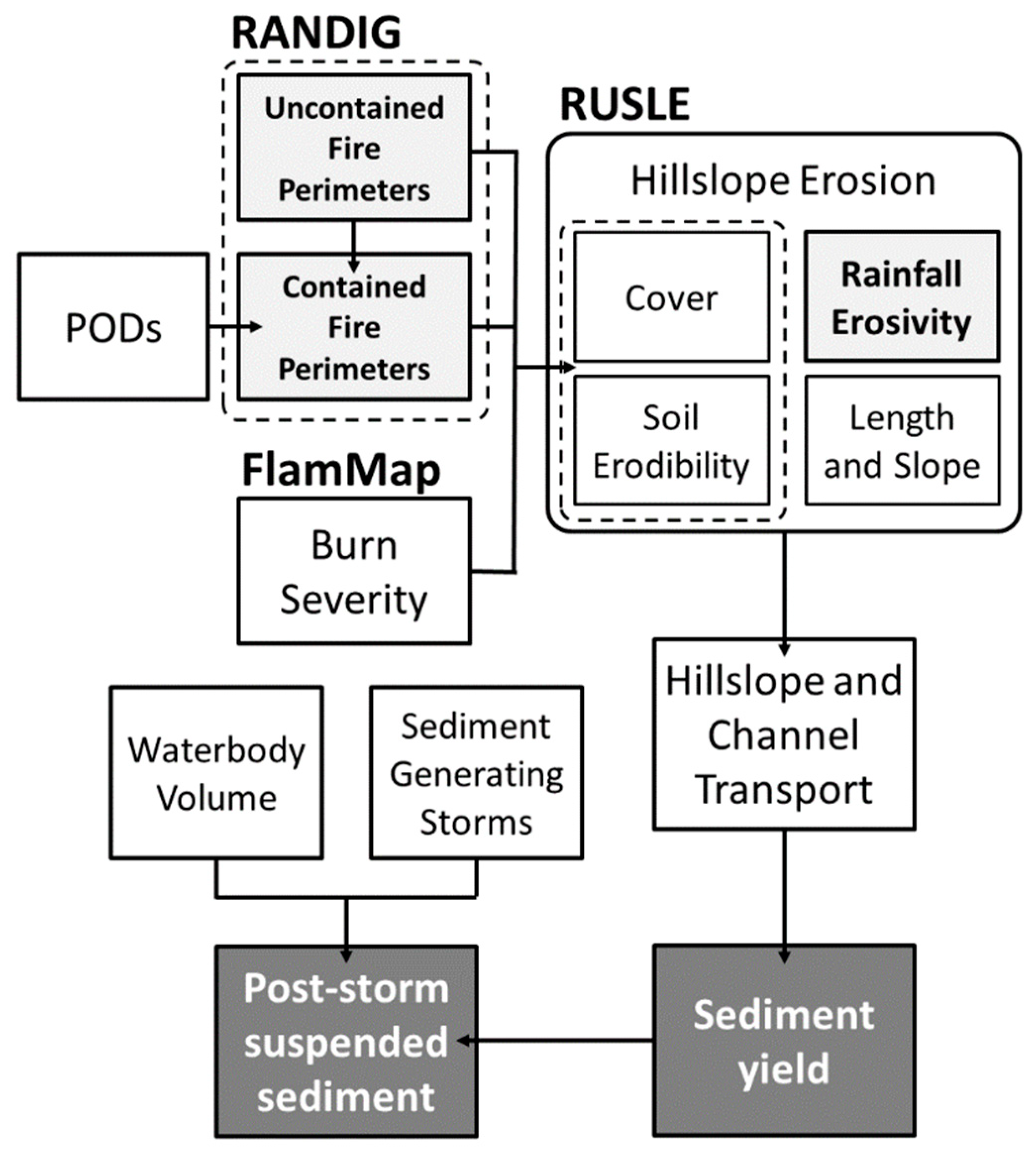
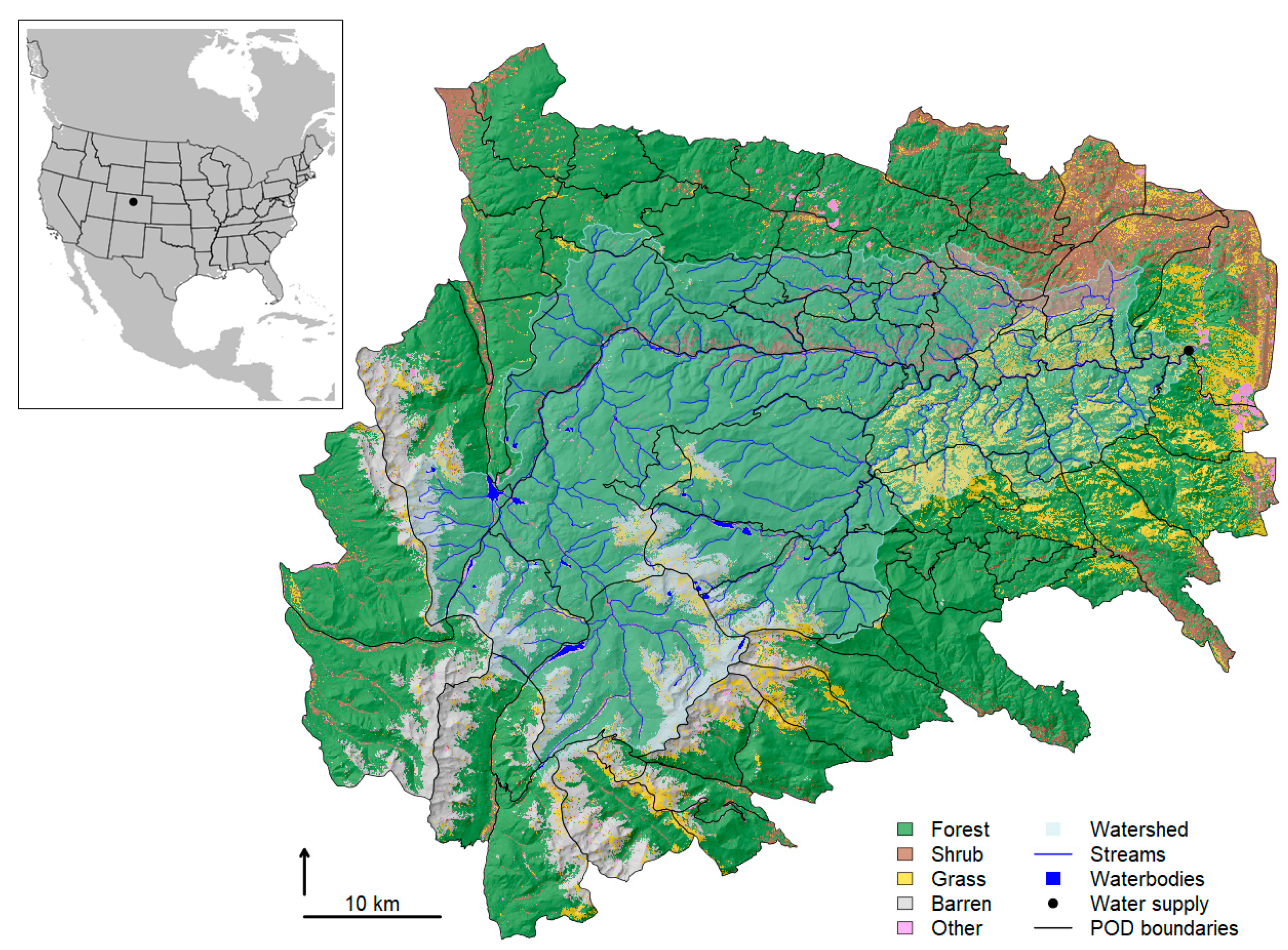

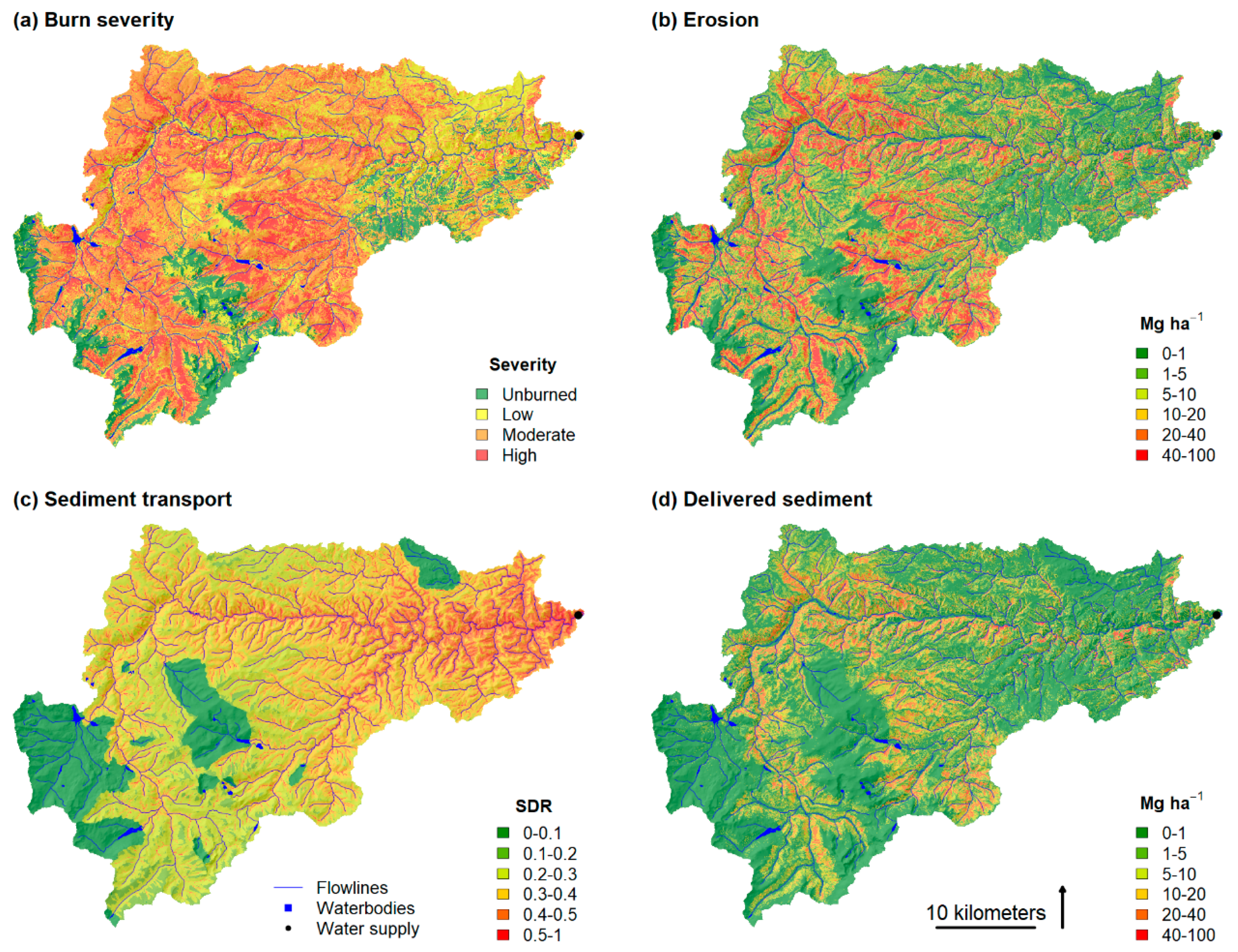
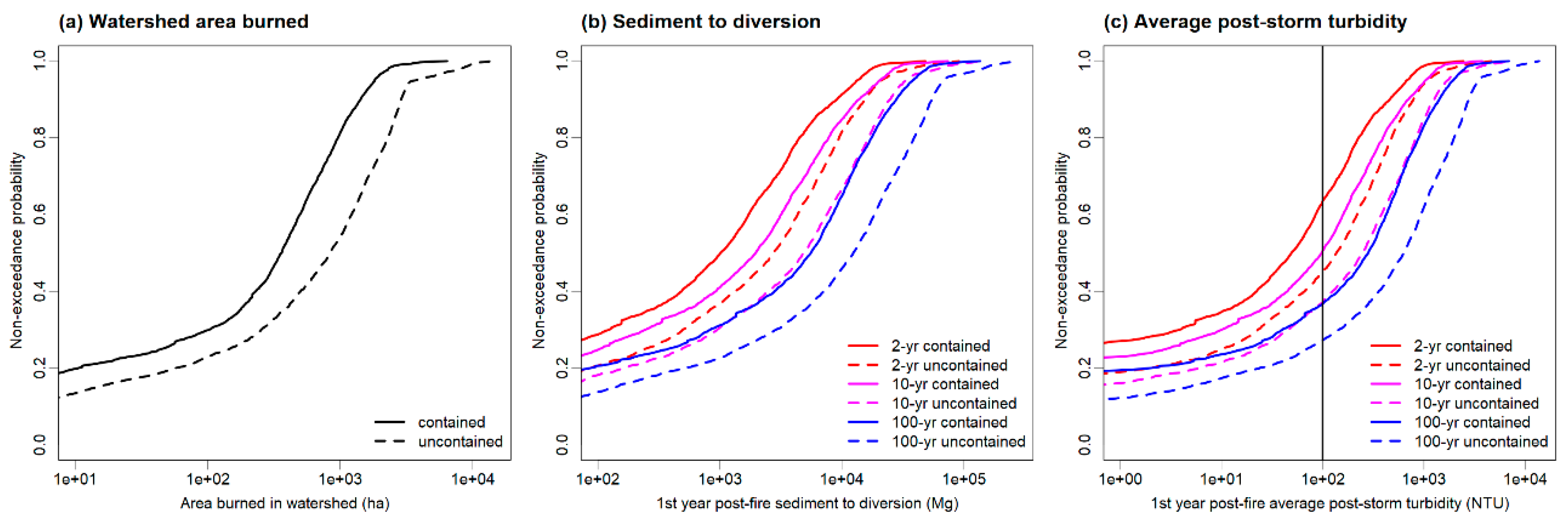
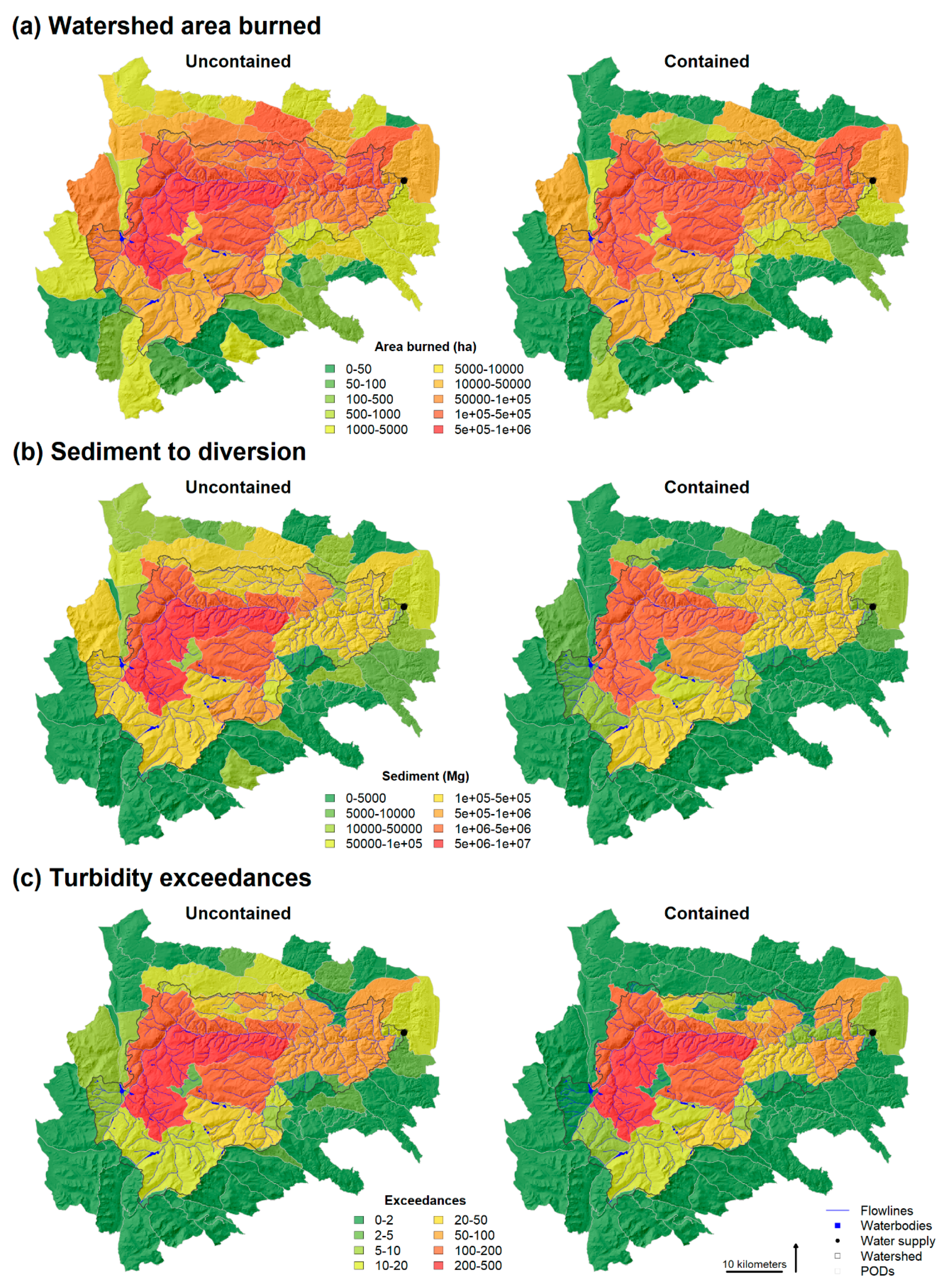
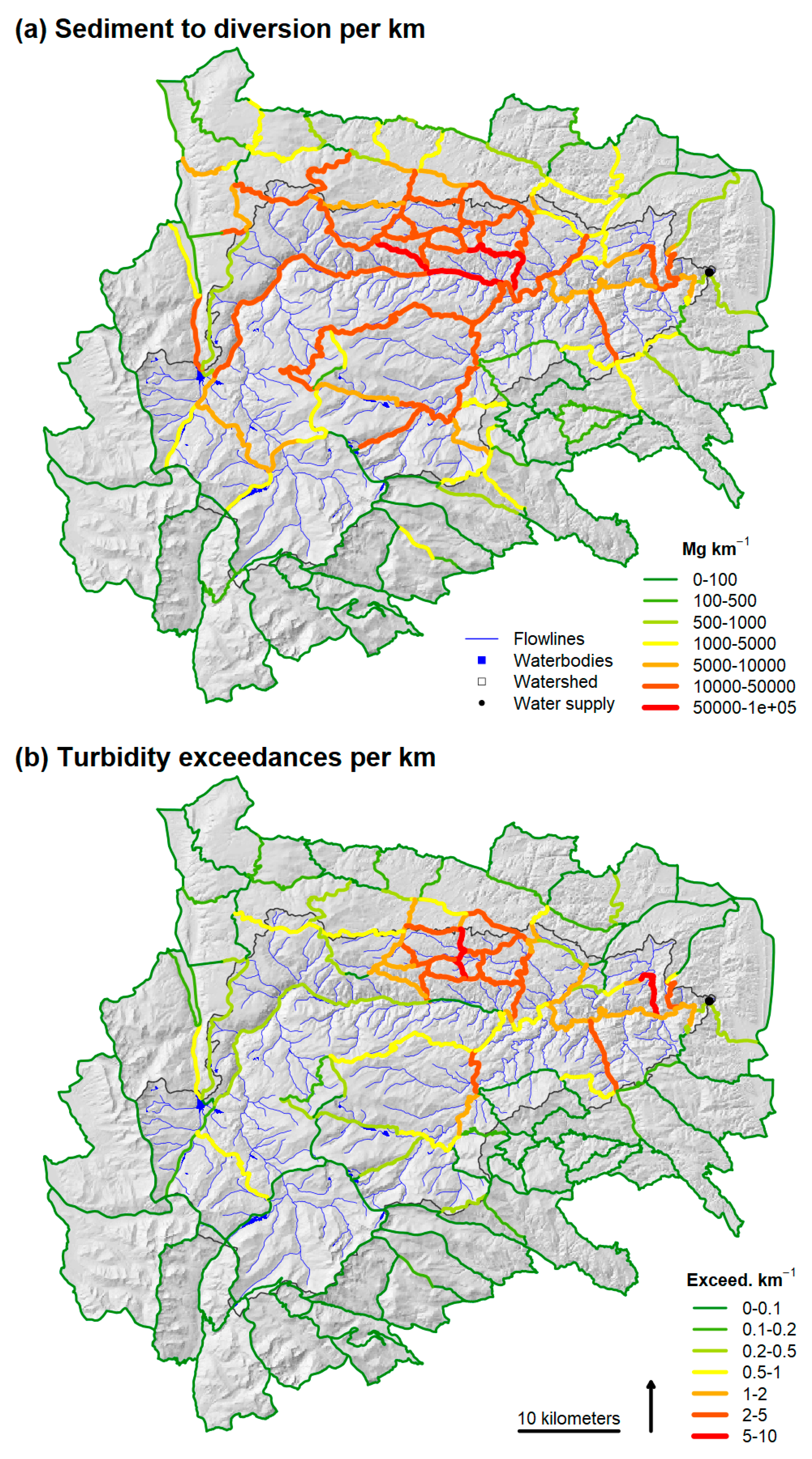
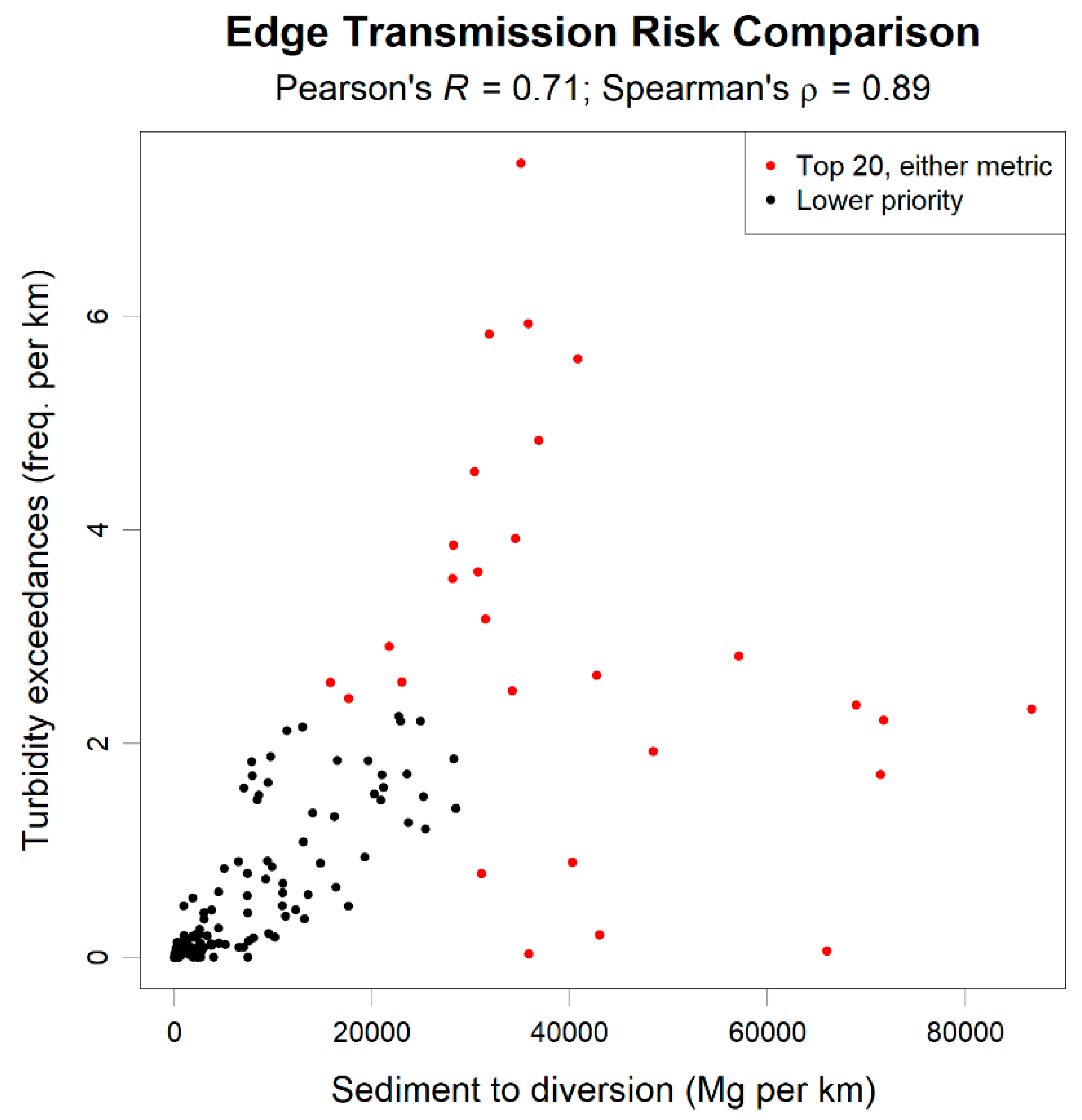
| Scenario | Wind Speed (kph at 6 m) | Direction (deg) | Spot Probability | Scenario Probability |
|---|---|---|---|---|
| 1 | 16.1 | 225 | 0.02 | 0.259 |
| 2 | 16.1 | 270 | 0.02 | 0.431 |
| 3 | 16.1 | 315 | 0.02 | 0.210 |
| 4 | 32.2 | 225 | 0.05 | 0.020 |
| 5 | 32.2 | 270 | 0.05 | 0.034 |
| 6 | 32.2 | 315 | 0.05 | 0.016 |
| 7 | 48.3 | 225 | 0.1 | 0.009 |
| 8 | 48.3 | 270 | 0.1 | 0.014 |
| 9 | 48.3 | 315 | 0.1 | 0.007 |
| 2-Year Rainfall Erosivity | 10-Year Rainfall Erosivity | 100-Year Rainfall Erosivity | |||||||
|---|---|---|---|---|---|---|---|---|---|
| Statistic | Erosion | To Streams | To div. | Erosion | To Streams | To div. | Erosion | To Streams | To div. |
| Lower decile | 2.0 | 1.0 | 0.4 | 4.3 | 2.1 | 0.9 | 18.5 | 9.1 | 4.3 |
| Lower quartile | 5.0 | 2.6 | 1.6 | 9.8 | 5.0 | 3.2 | 32.3 | 16.5 | 11.0 |
| Median | 9.0 | 4.7 | 3.3 | 16.5 | 8.6 | 6.2 | 45.2 | 23.4 | 16.8 |
| Mean | 12.3 | 6.2 | 4.2 | 20.4 | 10.3 | 7.0 | 46.4 | 23.4 | 15.9 |
| Upper quartile | 16.8 | 8.6 | 6.0 | 28.1 | 14.3 | 9.9 | 60.8 | 30.7 | 21.5 |
| Upper decile | 27.7 | 13.7 | 8.7 | 42.9 | 20.9 | 13.6 | 75.3 | 36.8 | 24.7 |
| Watershed Area Burned (Mean ha per Fire) | ||||
|---|---|---|---|---|
| Self-burning | Total | Avoided | Avoided (%) | |
| 562 | 1361 | 799 | 58.7 | |
| Sediment to Diversion (Mean Mg per Fire) | ||||
| Rainfall Erosivity | Self-Burning | Total | Avoided | Avoided (%) |
| 2-year | 3031 | 6115 | 3085 | 50.4 |
| 10-year | 4904 | 10,188 | 5284 | 51.9 |
| 100-year | 10,411 | 23,273 | 12,863 | 55.3 |
| Turbidity Exceedances (Count of Fires) | ||||
| Rainfall Erosivity | Self-Burning | Total | Avoided | Avoided (%) |
| 2-year | 1110 | 1668 | 558 | 33.5 |
| 10-year | 1503 | 1910 | 407 | 21.3 |
| 100-year | 1922 | 2210 | 288 | 13.0 |
© 2020 by the authors. Licensee MDPI, Basel, Switzerland. This article is an open access article distributed under the terms and conditions of the Creative Commons Attribution (CC BY) license (http://creativecommons.org/licenses/by/4.0/).
Share and Cite
Gannon, B.M.; Wei, Y.; Thompson, M.P. Mitigating Source Water Risks with Improved Wildfire Containment. Fire 2020, 3, 45. https://doi.org/10.3390/fire3030045
Gannon BM, Wei Y, Thompson MP. Mitigating Source Water Risks with Improved Wildfire Containment. Fire. 2020; 3(3):45. https://doi.org/10.3390/fire3030045
Chicago/Turabian StyleGannon, Benjamin M., Yu Wei, and Matthew P. Thompson. 2020. "Mitigating Source Water Risks with Improved Wildfire Containment" Fire 3, no. 3: 45. https://doi.org/10.3390/fire3030045
APA StyleGannon, B. M., Wei, Y., & Thompson, M. P. (2020). Mitigating Source Water Risks with Improved Wildfire Containment. Fire, 3(3), 45. https://doi.org/10.3390/fire3030045






